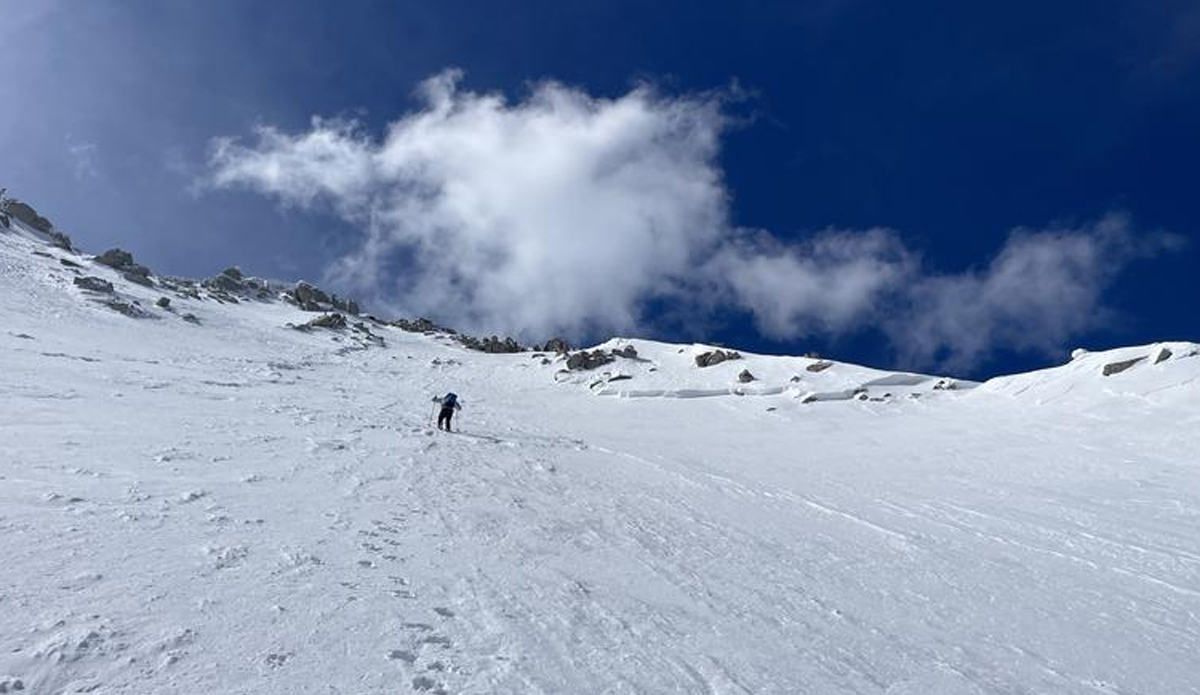
Hiking up the bed surface of the avalanche the following day. Photo: Utah Avalanche Center
On Thursday, May 9, 2024, Austin Mallet, 32, and Andrew Cameron, 22, tragically died in an avalanche near Lone Peak Summit in Utah. A third, unnamed 23-year-old skier survived the slide, which came on the heels of a May storm that left up to two feet of new snow in the area. Now, an accident report published by the Utah Avalanche Center has revealed new details of the incident. The surviving skier’s account details the slide that sent him tumbling 300 feet down the mountain, and the harrowing story of his attempts to save his friends’ lives.
According to the report, the trio began their day around 5:00 a.m., when they began hiking up the Sawmill trail to access the Big Willow Drainage, hoping to use the Big Willow Aprons as an approach to Lone Peak. When they reached snow, they switched to skis until, after three and a half hours, the group reached the bottom of Big Willow Cirque. From there, they went up as far as they could, before switching to bootpack.
At 9:44 a.m. the group was moving diagonally across the slope, with the surviving skier in the lead. The friend remembered “wallowing” in deep snow, and not feeling any supportable layer underneath, but not noticing any obvious signs of instability. He had just crossed a fin of rock and snow, when the avalanche broke above and around them. He was knocked off his feet and tumbled head over heels down the slope for about 300 vertical feet, before coming to a stop sitting upright, partially buried with his right arm free. The man then dug himself out and skied down to the bottom of the fin, believing at the time that he was the only one who had been caught in the avalanche and his partners were on the other side of the outcropping.

The fin on Big Willow Aprons. The X’s mark the skiers’ positions just before the avalanche. Photo: Utah Avalanche Center
Once he was there, though, he realized that the other side of the fin had slid even bigger. He immediately yelled for his partners and turned his transceiver to receive, but had to ski down the slope to reach the range of his friends’ transceivers. After acquiring signal, he found a ski on top of the avalanche debris and began searching the area. About 13 minutes after the initial slide, he located Austin. He dug his friend out and gave a few rescue breaths, but got no response. Realizing that there was nothing more he could do, he turned his focus to finding Andrew.
The skier turned to the transceiver again, but initially was steered back towards Austin’s body and had to flag his signal. Finally he acquired Andrew’s signal and started a search. After several attempts, he finally found him, uncovered his head, cleared his airway and performed rescue breaths. However, Andrew did not start breathing.
From there, the skier called 911. At first, he continued to unbury the other two while he waited for help to arrive, but eventually stopped, believing they were dead. About an hour after the avalanche, an air ambulance arrived on the scene, but had to circle due to poor visibility. Finally, when the clouds parted long enough to evaluate the area, the surviving skier was evacuated and transported via ground ambulance to a hospital. Poor conditions and additional avalanche hazards prevented rescuers from recovering Mallet’s and Cameron’s bodies until the next morning.
“The Utah Avalanche Center would like to express our appreciation to the friend of the victims for sharing his experience in great detail during such a difficult time,” concluded the report. “His input has been invaluable in helping us understand the events that led to this tragic accident. As with all avalanche accidents, we all hope to learn something so that future accidents may be prevented. Our deepest condolences go out to the friends, family, rescuers, and everyone affected by the accident.”

